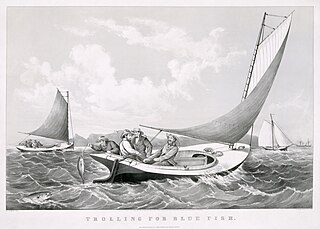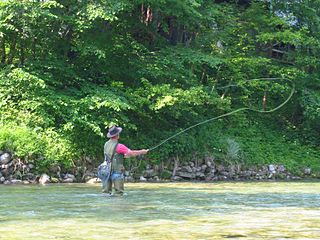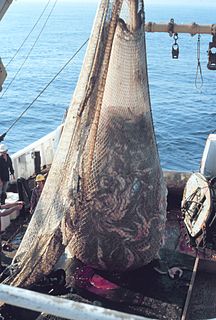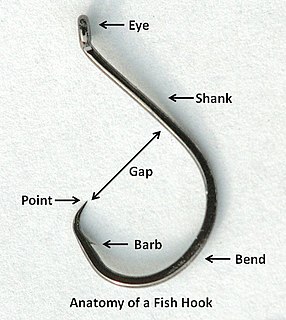
Trolling is a method of fishing where one or more fishing lines, baited with lures or bait fish, are drawn through the water. This may be behind a moving boat, or by slowly winding the line in when fishing from a static position, or even sweeping the line from side-to-side, e.g. when fishing from a jetty. Trolling is used to catch pelagic fish such as salmon, mackerel and kingfish.

Fly fishing is an angling method in which an artificial "fly" is used to catch fish. The fly is cast using a fly rod, reel, and specialized weighted line. Casting a nearly weightless fly or "lure" requires casting techniques significantly different from other forms of casting. Fly fishermen use hand tied flies that resemble natural invertebrates, baitfish, other food organisms, or "lures" to provoke the fish to strike.

Angling is a method of fishing by means of an "angle". The hook is usually attached to a fishing line and the line is often attached to a fishing rod. Modern fishing rods are usually fitted with a fishing reel that functions as a mechanism for storing, retrieving and paying out the line. Tenkara fishing and cane pole fishing are two techniques that do not use a reel. The hook itself can be dressed with bait, but sometimes a lure, with hooks attached to it, is used in place of a hook and bait. A bite indicator such as a float, and a weight or sinker are sometimes used.

Trawling is a method of fishing that involves pulling a fishing net through the water behind one or more boats. The net that is used for trawling is called a trawl.

Esox is a genus of freshwater fish, the only living genus in the family Esocidae—the esocids which were endemic to North America and Eurasia during the Paleogene through present.

Catch and release is a practice within recreational fishing intended as a technique of conservation. After capture, the fish are unhooked and returned to the water. Often, a fast measurement and weighing of the fish is worthwhile. Using barbless hooks, it is often possible to release the fish without removing it from the water.

A fishing lure is a type of artificial fishing bait which is designed to attract a fish's attention. The lure uses movement, vibration, flash and color to bait fish. Many lures are equipped with one or more hooks that are used to catch fish when they strike the lure. Some lures are placed to attract fish so a spear can be impaled into the fish or so the fish can be captured by hand. Most lures are attached to the end of a fishing line and have various styles of hooks attached to the body and are designed to elicit a strike resulting in a hookset. Many lures are commercially made but some are hand made such as fishing flies. Hand tying fly lures to match the hatch is considered a challenge by many amateur entomologists.

Handline fishing, or handlining, is a fishing technique where a single fishing line is held in the hands. It is not to be confused with handfishing. One or more fishing lures or baited hooks are attached to the line. A hook, fishing lure, or a fishing jig and many times a weight and/or a fishing float can be attached to the line. Handlining is among the oldest forms of fishing and is commonly practiced throughout the world today.

A deadeye is an item used in the standing and running rigging of traditional sailing ships. It is a smallish round thick wooden disc with one or more holes through it, perpendicular to the plane of the disc. Single and triple-hole deadeyes are most commonly seen. The three-holed blocks were called deadeyes because the position of the three holes resemble the eye and nose sockets of a sheep's skull.
Flossers are anglers who use the method of bottom bouncing or lining to catch fish. Their catch is mainly from the salmon species.

Fishing tackle is the equipment used by anglers when fishing. Almost any equipment or gear used for fishing can be called fishing tackle. Some examples are hooks, lines, sinkers, floats, rods, reels, baits, lures, spears, nets, gaffs, traps, waders and tackle boxes.

Plugs are a popular type of hard-bodied fishing lure. They are widely known by a number of other names depending on the country and region. Such names include crankbait, wobbler, minnow, shallow-diver and deep-diver. The term minnow is usually used for long, slender, lures that imitate baitfish, while the term plug is usually used for shorter, deeper-bodied lures which imitate deeper-bodied fish, frogs and other prey. Shallow-diver and deep-diver refer to the diving capabilities of the lure, which depends on the size and angle of the lip, and lure buoyancy.

A fishing vessel is a boat or ship used to catch fish in the sea, or on a lake or river. Many different kinds of vessels are used in commercial, artisanal and recreational fishing.

Fishing techniques are methods for catching fish. The term may also be applied to methods for catching other aquatic animals such as molluscs and edible marine invertebrates.
Drop shotting is a high finesse technique for fishing plastic baits, and consist of a small thin-wire hook with a weight attached to the tag end of the line. This is in contrast to the more traditional Texas Rig, where the weight slides inline, resting on the nose of the bait, or the Carolina Rig, where the weight is fixed above the bait. The drop shot rig provides the ability to keep a lure off the bottom, with weightless action. Usually the bait is fished by letting the weight hit the bottom and then shaking the lure by twitching the rod. But can also be flipped, dragged, hopped, or jigged along the bottom. This simple, but versatile technique has endless combinations with the different hooks, soft plastics and weights that can be used.[1] The aim is to present a free floating, slow twitching lure to induce a strike from non-aggressive fish.This rigs known use is in bass fishing commonly used for catching Smallmouth Bass, Largemouth Bass, and Spotted Bass. But can also be used for a variety of other fish species.

A splinter is a fragment of a larger object, or a foreign body that penetrates or is purposely injected into a body. The foreign body must be lodged inside tissue to be considered a splinter. Splinters may cause initial pain through ripping of flesh and muscle, infection through bacteria on the foreign object, and severe internal damage through migration to vital organs or bone over time.

A double seam is a canning process for sealing a tin can by mechanically interlocking the can body and a can end.
Hook, Lion and Sinker is a Disney animated episode featuring Donald Duck, who appears as a fisherman, and Louie the Mountain Lion. This is the second episode to feature Louie and the only episode where he is shown to have a son. The film's plot centers on the lions trying to steal Donald's catch of fish. The title is a pun on the phrase "hook, line and sinker".

A fish stringer is a line of rope or chain along which a fisherman can string fish so they can be immersed and kept alive in water.


















